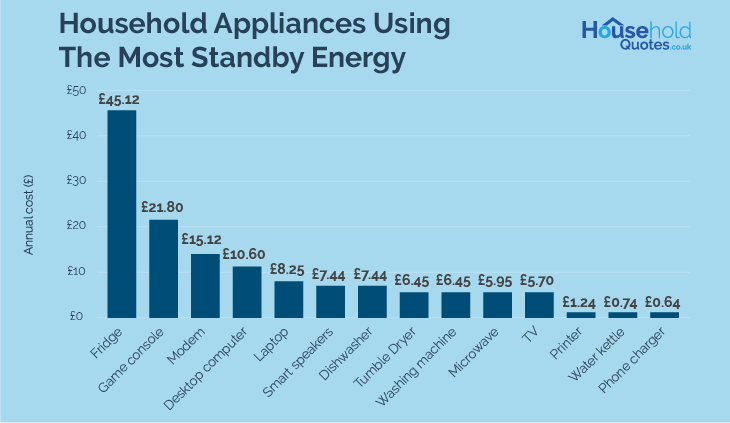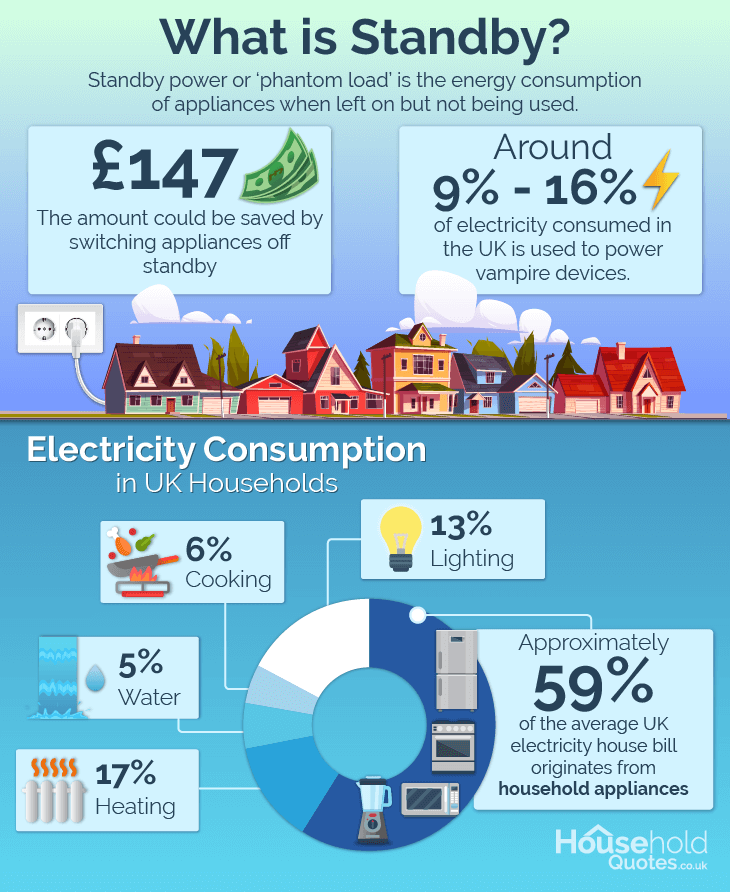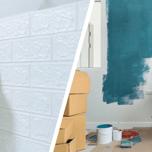- Householdquotes.co.uk
- Blog
- Energy Consuming Appliances
17 Appliances Consuming The Most Energy in Your Home


Home appliances are not just modern conveniences; they are significant energy consumers. The average 3-person British household uses around 2,700kWh of electricity, translating to an average annual energy bill of £1,625.
Alarmingly, a whopping 30% of that cost – nearly £488 – is wasted on phantom loads! These are the electronic devices that silently consume energy even when switched off, leeching away at your electricity use and driving up your bill like energy vampires.
This doesn't have to be the case. Keep reading to discover simple and effective ways to slash your phantom load and reclaim control of your energy consumption.
What are phantom loads?

Phantom loads, also known as vampire loads or standby power, refer to the electricity consumed by appliances and electronic devices when they are turned off or in standby mode but still plugged into an outlet.
Standard household devices contributing to phantom loads include TVs, cable/satellite boxes, computers, printers, game consoles, chargers for phones/laptops, microwaves, and coffee makers.

How to reduce phantom loads?
Thankfully, there are several simple steps you can take to minimise the impact of phantom loads.
1. Unplug devices: Unplugging appliances and electronics when not in use is the most effective way to eliminate phantom loads.
2. Use power strips: Plug devices into power strips and switch them off when not in use. Smart power strips can automatically cut off power to devices that are not in use.
3. Look for energy-efficient devices: When purchasing new appliances, choose models that are designed to minimise standby power consumption. Energy-efficient devices are specifically designed to reduce phantom loads.
4. Adjust device settings: Many devices have "sleep settings" that allow you to reduce their power consumption when they're not in use. For example, you can set your TV to turn off automatically when it's not being used.
5. Be mindful of charging: Charging your devices overnight may be convenient but it also leads to vampire energy. Instead, try to charge your devices during the day when you're more likely to be using them.
Energy consumption in the kitchen
The kitchen is one of the most energy-intensive areas in a home, with cooking accounting for about 6% of the average household's energy bill. The key contributors include fridges, ovens, dishwashers, toasters, and kettles.
Refrigerators
Refrigerators are among the most energy-intensive kitchen appliances, with fridge-freezers accounting for 12% of household energy bills. Modern refrigerators are much more efficient than older models, consuming about 62% less electricity while offering double the storage volume compared to 1992 models.
Keep your refrigerator at 3-4°C (37-40°F) and your freezer at -18°C (0°F). A full refrigerator retains cold better than an empty one. Dusty coils force the refrigerator to work harder, consuming more energy.
Ovens
Ovens are inefficient due to the need to heat a large space. Electric ovens typically use 1,000-5,000W, with an average of around 2,400W for standard models. On the other hand, convection ovens are more energy efficient due to their fan and exhaust system, averaging around 2,500.
The best energy-saving tip would be to avoid using your oven for short periods of time. Instead, use slow cookers, microwaves, or air fryers for cooking.
Microwaves
These are generally more energy-efficient than conventional ovens for short cooking tasks. A 700W microwave used for 3 minutes consumes around 0.035kWh of energy. To compare, using an average 240W oven for 3 minutes would consume 0.12kWh.
Using microwave-safe plastic lids, plates, or microwave cover accessories helps contain splattering, retain moisture, and allow more efficient cooking.
Dishwashers
Dishwashers use 1,200 - 2,400 watts per cycle, with an average of around 1,800. While dishwashers are energy-efficient when running, they do use a small amount of power, even in standby mode. This standby usage amounts to only 3 watts, which might seem insignificant. However, this standby power can add up to an annual cost of around £7.44.
Use the air-dry or eco setting instead of heated drying. Also, you should avoid running the dishwasher if it’s not fully loaded.
Kettles
A kettle's energy consumption depends on its wattage and duration of use. For example, a 1,500W kettle used for 30 minutes (0.5 hours) would consume 0.75kWh.
Descale the kettle regularly for better efficiency. Also, boiling only the amount of water needed using an energy-efficient kettle can save up to 30% of energy.
Energy consumption in the living room
The living room can significantly contribute to a household's energy consumption, primarily due to the use of electronic devices and lighting.
For example, a gaming laptop can consume around 1kWh every few hours. Additionally, a single 100 watt lightbulb can consume 1kWh of electricity per day.
Video game console
Video game consoles like the Xbox One, PS5, and Nintendo Switch can consume significant amounts of electricity, especially during active gaming sessions. For example, the Xbox 360 consumes about 125 watts per hour, while the PS3 uses around 107 watts per hour.
Modern consoles have energy-saving modes that reduce power consumption when the console is not in use. For instance, the Xbox One's "Energy-saving" mode can reduce standby power use by 98%.
Consoles can draw power even when not used, especially if left in standby mode. Features like gesture recognition and network connectivity can contribute to this phantom load.
If your energy provider offers lower rates during certain times, try to game during these periods. Other than that, completely power down the console and disconnect the controllers and VR headsets when your console is idle.
Television
Modern TVs typically consume between 50 and 200 watts. For example, a 32-inch TV uses about 28 watts, while a 75-inch TV can use up to 114.5 watts. In standby mode, TVs consume between 0.5 and 3 watts. The average standby power consumption is around 1.3 watts.
Apart from the standard ‘unplug-it-completely’ recommendations, you could try enabling features like automatic TV brightness control and energy-saving modes. Alternatively, you could set a sleep timer to turn off the TV automatically.
Smart home devices
Smart home devices like smart speakers, thermostats, and security cameras typically consume low amounts of power but can add up due to their always-on nature.
Based on the energy rate of 28 pence, the annual running cost for smart speakers is £2.89. For a smart thermostat, it's £2.64; for a smart security camera, it's £3.37.
Use voice commands to control these devices and set routines to turn them off automatically or to go to ‘sleep mode’ when you leave home or go to bed. Opt for battery-powered or solar-powered cameras that don’t require constant electricity.
Phone charger
Phone chargers consume a small amount of energy when charging, but this can add up if left plugged in all the time. Using the original charger provided by the manufacturer is more efficient than using third-party chargers.
If you would like to prevent unnecessary energy use, don’t leave your phone charging overnight. Alternatively, you could enable low power mode on your phone to reduce the charging frequency.
Electric underfloor heating
Underfloor heating (UFH) systems can be divided into two main types: wet systems and dry systems. Wet UFH systems use water heated by a boiler or heat pump, which is then circulated through pipes laid under the floor.
Running a 150W/m² system costs approximately 1.5 pence per hour per square meter, while a 200W/m² system costs about 2 pence per hour per square meter. For a 10m² room with a 200W/m² system, the cost would be around 20 pence per hour.
Proper insulation can significantly reduce heat loss, making the system more efficient. Insulation boards can reduce heat-up times and increase energy efficiency by up to 50%.
Energy consumption in the bathroom
The bathroom's energy consumption is largely driven by water heating and lighting.
Shower
A typical 10-minute electric shower uses 8kWh of energy, translating to roughly 37 pence at current rates. That means a daily 10-minute hot shower can cost a surprising £137 over a year!
The best energy-saving tip? Aim for shorter showers – even a few minutes can make a big difference. Also, a slightly cooler shower can still be comfortable and use less energy. Alternatively, you could explore alternative hot water sources like solar water heaters or heat pumps.
Water heaters
A typical electric water heater in the UK might use around 10kWh to heat a full tank. Considering an average electricity price of 18 pence per kWh, this translates to roughly £1.80 per full heating cycle.
Set the water heater to 49℃ (120℉). Insulate the water heater and pipes to retain heat. Alternatively, consider installing a tankless water heater which heats water on demand and can be 24 – 35% more energy efficient than traditional storage tank water heaters.
Ventilation
The cost of ventilation systems depends on their complexity and size. Simple ventilation systems can cost around £10 - £20 per month to run, while more complex systems with heat recovery might cost more.
Use energy efficient ventilation fans, with a ErP rating of A or above, to save up to 60% in energy costs. Properly seal and insulate ductwork or pipework to prevent energy loss.
Energy consumption in the laundry room
Washing machine
A washing machine consumes around 35kWh per month, costing £11.90 per month or approximately £143 per year. Running a washing machine in standby mode will cost you around £6.45 annually.
Run full loads to maximise efficiency. Compared to warm water, using cold water for washing could cut energy use by more than half. Also, A-rated ErP (energy efficiency rating) washing machines use 25% less energy and 33% less water than conventional models.
Clothes dryer
A 45-minute drying cycle with a 5,000W clothes dryer can consume about 3.5kWh of electricity.
Every month, it consumes around 56.25kWh, costing £19.13 or approximately £230 per year. In standby mode, it can cost £6.45 to run per year.
Clean the lint filter after every load to improve air circulation and efficiency. When using the dryer, use the moisture sensor setting to avoid over-drying and wasting energy.
Energy consumption in the whole house
HVAC systems
Heating, ventilation and air conditioning (HVAC) systems are the largest energy consumers in most homes. They account for more than 60% of the energy consumption of buildings in the UK and make up 17% of your electricity bill.
Replace HVAC filters every 1-3 months to improve efficiency and indoor air quality. Ceiling fans can help circulate air and make a room feel cooler, allowing you to raise the thermostat setting a few degrees. On top of that, remember to improve insulation in walls, attics, and crawl spaces to reduce heat transfer. Seal air leaks around windows, doors, and other openings to prevent conditioned air from escaping.
Upgrading to a high-efficiency HVAC system can save up to 20% on heating and cooling costs. Also, pairing cooling installations with solar photovoltaic (PV) arrays can dramatically reduce energy bills associated with cooling.
For optimal air conditioning, set the thermostat to a higher temperature when possible, as every degree above 22℃ (72℉) saves 3-5% on cooling costs. Shade windows with curtains, blinds, or awnings to reduce heat gain from sunlight.
Lightning
Did you know leaving a 100W lightbulb on for an entire day can add up? In general, lightning expenses make up 13% of your electricity bills.
Our calculations show it uses about 3 pence per hour, so leaving it on for 24 hours would cost you approximately 72 pence.
Replacing incandescent bulbs with energy-efficient LED or CFL bulbs saves up to 75% in energy costs. Use motion sensors or timers to automatically turn off lights when not needed.

You can significantly reduce your energy consumption by making minor adjustments in your daily routine and utilising energy-saving features. This will save you money on your bills and contribute to a more sustainable future. Remember, every little bit counts!




